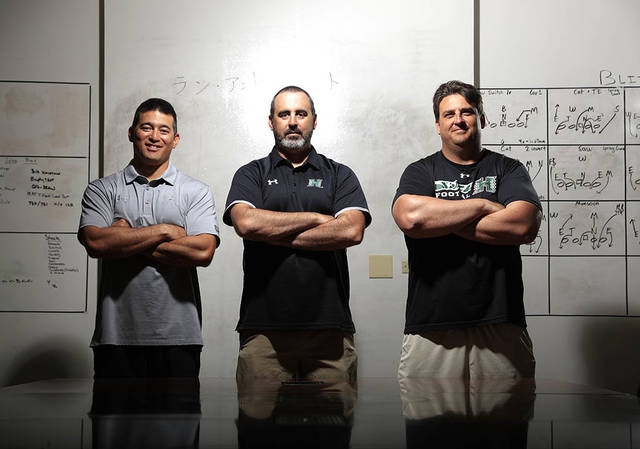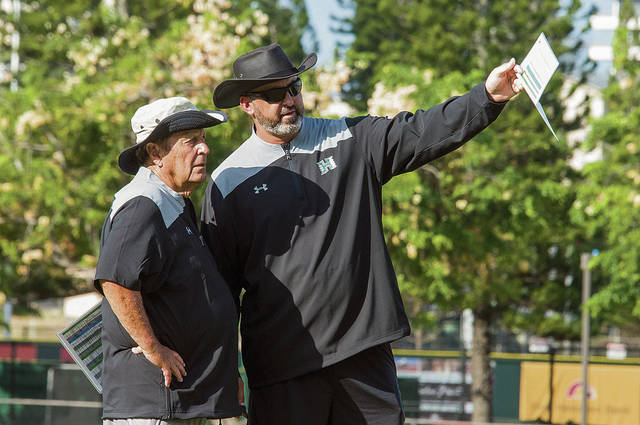Rolovich is bringing back the run-and-shoot in his drive to recapture the glory days


JAMM AQUINO / 2007
Hawaii’s success with the run-and-shoot offense peaked during its undefeated 2007 regular season, after which quarterback Colt Brennan was third in the voting for the Heisman Trophy. Here, Brennan celebrated with fans following UH’s 39-27 victory over Boise State, clinching the Western Athletic Conference championship. A week later, the Warriors ran their record to 12-0 with a win over Washington, clinching a spot in the Sugar Bowl against Georgia.

JAMM AQUINO / JAQUINO@STARADVERTISER.COM
Craig Stutzmann, Nick Rolovich and Brian Smith don’t have much time these days to reflect on their glorious 2001 season as key players in Hawaii’s run-and-shoot. They are busy teaching it to the current Warriors as quarterbacks coach, head coach and running backs coach. Stutzmann is also passing game coordinator and Smith is offensive coordinator.

CRAIG T. KOJIMA / CKOJIMA@STARADVERTISER.COM
Mouse Davis, left, is the coach most noted for developing the foundation of the run-and-shoot passing game. The former University of Hawaii assistant recently visited Warriors practice, where coach Nick Rolovich is bringing back the four-wide offense.




In an effort to win games and recapture its dwindling fan base, the University of Hawaii football program is reinstalling an offense that has become ingrained in island football lore.
Welcome back, run-and-shoot.
It made record-setting UH players famous and June Jones a household name, created a dynasty in prep football and changed Hawaii’s football landscape.
“I think it attracted more people to the game,” said Jones. He quarterbacked the run-and-shoot and has coached it at many stops. That includes Hawaii from 1999 to 2007, where the offense was instrumental in rebuilding UH football and taking it to previously unimagined heights.
It worked then. Could it now?
It’s seems like a natural for current UH coach Nick Rolovich, who excelled while playing in it and coached it.
Don't miss out on what's happening!
Stay in touch with breaking news, as it happens, conveniently in your email inbox. It's FREE!
>> What makes the UH offense tick?
>> Price was right by putting more defensive backs on the field
>> Rolovich is bringing back the run-and-shoot in his drive to recapture the glory days
>> How the run-and-shoot offense was born after Mouse was inspired by Tiger’s tale
>> How the run-and-shoot got here and became a staple in Hawaii football landscape
RELATED PHOTOS AND VIDEOS
>> UH football team brings back run-and-shoot offense to be more competitive
>> Darrel “Mouse” Davis gives a quick rundown of the run-and-shoot offense
>> UH football trains without naming starting quarterback
There also have been no winning seasons for Hawaii in the six years since the run-and-shoot offense left town.
“I’m excited for Rolo,” said Ron Lee, his predecessor as Warriors OC who has been coaching the run-and-shoot in Hawaii for 43 years. “I think the change is going to help him, especially since he has so many coaches who are familiar with it. It is going to be a little more difficult than in the old days. Back when June was here not everyone was running four receivers, so what you’ll see now is defenses a lot more familiar with the formations and defenses a lot more well prepared for the route adjustments than 15 years ago. But it is going to be exciting. Fire it up! Put pressure on the defense!”
Must be in sync
The run-and-shoot puts pressure on its own defense, too, if it is misfiring. There are often more “three-and-outs,” or series that don’t result in a first down and don’t take much time off the clock, than in a running offense. It can also result in plenty of turnovers if quarterbacks and receivers are not in sync, or — as in any passing offense — if protection of the quarterback breaks down.
If the bottom line is winning more than losing, the run-and-shoot is clearly the University of Hawaii football program’s most successful offense of UH’s 40-plus years in Division I.
Run-and-shoot
>> 105 wins
>> 66 losses
Non run-and-shoot
>> 161 wins
>> 196 losses
>> 6 ties
Spread formations
>> 163 wins
>> 115 losses
>> 3 ties
Conventional formations
>> 103 wins
>> 147 losses
>> 3 ties
“I’m rooting for Nick and his crew,” said Mouse Davis, who developed the run-and-shoot into a pass-first offense in the 1960s and ’70s and coached with Rolovich at UH in 2008 and 2009. “You gotta get started with a quarterback, and the good thing is Nick is a quarterback so he’ll know it when he sees it. And you also gotta be strong on defense.”
Jones knew it when he saw Rolovich and the others. Just as Davis knew it when he saw Jones and convinced the Oregon and Hawaii transfer to give it one more shot as a quarterback at Portland State in his crazy new offense in 1975. The run-and-shoot helped Jones make it to the NFL, where he played four seasons with the Atlanta Falcons and later became a head coach. His long coaching career has included many partnerships with his mentor, in the college and professional ranks.
None of it would have happened without Davis’ persistence, Jones said.
“Yeah, that’s accurate,” said Jones, who is now head coach at Hamilton of the Canadian Football League. “He called me three or four times. I’d already been to two colleges, and I told him it’s just not gonna work. He called me one more time the week before camp, and I said, ‘OK.’ If he hadn’t called again we’d probably not be having this conversation. Playing in the NFL? Definitely not. I would’ve found something I liked, but not as much as I like football. I like being around the kids.”
Square pegs, round holes
Jones was hired at UH in 1999 and, in swift and stunning fashion, elevated Hawaii from worst to first in the Western Athletic Conference. Now, one of his proteges will try to do the same in the Mountain West, with the same offensive scheme.
The run-and-shoot was also the Warriors’ base offense when Rolovich coached the UH quarterbacks and served as offensive coordinator from 2008 to 2011.
He didn’t install it immediately upon his hiring as head coach prior to the 2016 season. It was a case of square pegs and round holes, and a program and fan base weary from five straight losing seasons, Rolovich said.
“I felt that this community and this team needed to win fast as we could, and I’m not sure if we were built to be a run-and-shoot team at that time,” said Rolovich, who attained experience directing a more run-oriented attack as Nevada’s offensive coordinator from 2012 to 2015.
Rolovich’s predecessor as UH head coach, Norm Chow, had recruited toward building a team that would run more than pass. When Rolovich took over, the Warriors were deep at running back and the roster was loaded with big offensive linemen and tight ends.
Also, there was no quarterback with experience in the run-and-shoot. So he went with a hybrid offense that included a lot of the trendy run-pass option.
“We looked at the personnel on the team and talked a lot about how we could have the best opportunity to win right away,” said running backs coach and offensive coordinator Brian Smith, who was also Rolovich’s center at UH in 2001.
The improvement in 2016 was hard to argue with. UH went to its first bowl game in six years, and won it to finish 7-7 for its first non-losing season since capturing a share of the Western Athletic Conference championship in 2010.
But 2017 was a different story — a sad one for the Warriors and their fans. Hawaii regressed to 3-9, plagued by injuries and what Rolovich described as “a lot of drama around the program.”
Winning tradition
UH is back to where it was two years ago: tired of losing.
But the Warriors coaches have now had three offseasons to recruit players who better fit the run-and-shoot schemes.
Those who were recruited by Chow for a pro-set offense were given the chance to adapt. Some stayed, some chose to leave.
An example of the former is Dakota Torres, is a 6-foot-2, 245-pound senior who was a tight end. The run-and-shoot rarely uses a tight end, but Torres has enough athleticism to play a different receiver position, Smith said.
While large roster turnover means lack of experience on both sides of the ball, as well as special teams, the installation of the offense of UH’s most-recent glory days has created plenty of buzz — and hope.
It is, after all, the attack Jones used when Hawaii turned things around in 1999 to 9-4 after an 0-12 record the previous year. It’s also the offense with which the Warriors posted winning records in six out of seven seasons during the ’00s under Jones.
That includes 9-3 in 2001, when Rolovich, Smith and receiver Craig Stutzmann (now UH’s quarterbacks coach and passing game coordinator) were key components of an offense that was scoring at will by the end of the season.
It also includes a 23-4 run in 2006 and 2007 when quarterback Colt Brennan became a Heisman Trophy finalist while leading the Warriors to unprecedented heights, including an appearance in a lucrative BCS bowl game, the Sugar Bowl. But after an undefeated 2007 regular season, UH and the run-and-shoot fizzled on the national stage against Georgia.
Hawaii did go to two bowl games in the following four seasons as Greg McMackin, the team’s defensive coordinator, became head coach when Jones left UH days after the Sugar Bowl to coach Southern Methodist.
Now, third-year sophomore Cole McDonald is the only returning quarterback to have played in a game for Hawaii, serving as a backup last season. He was one of Rolovich’s first recruits, and as a young boy McDonald was inspired to play quarterback by following Brennan’s exploits of a decade ago.
“I knew it might take a couple of years to implement it,” McDonald said. “But I wanted to be here to bring that tradition back to Hawaii.”
As training camp was coming to a close and final preparations were being made for Saturday’s season-opening game at Colorado State, McDonald and true freshmen Jeremy Moussa and Chevan Cordeiro were locked in a close battle for the starting quarterback job.
Cordeiro directed Saint Louis School to a dramatic state championship victory with the run-and-shoot last fall. He is just the latest in a long line of Crusaders quarterbacks to thrive in the offense. It includes Marcus Mariota, who went on to win the Heisman Trophy at Oregon and be picked No. 2 in the 2015 NFL Draft by Tennessee, and Tua Tagovailoa, who as a freshman came off the bench to lead Alabama to a national championship last season.
Another Saint Louis alumnus, Timmy Chang, had high school and college careers that are most emblematic of how influential the run-and-shoot has been at both levels of football in Hawaii. Chang set national passing marks while quarterbacking Saint Louis to three Prep Bowl championships in the late ’90s, and for half of the next decade passed himself into the NCAA record book at UH as Jones’ run-and-shoot gathered steam.
“Shoot, I was in it for 12 years,” Chang said of the run-and-shoot. “All the way from seventh grade.”
John Ursua — who was leading the nation in receiving before an injury last year — looks like a great fit for the offense at slot. And junior college transfer Cedric Byrd was the star of spring practice and has been compared to Davone Bess, a Warriors standout at slot during the program’s best run-and-shoot years. Another newcomer, wide receiver JoJo Ward, could be the deep threat UH has lacked in recent seasons.




